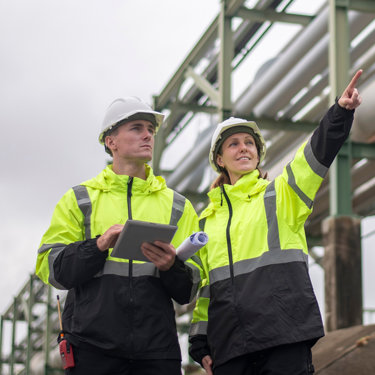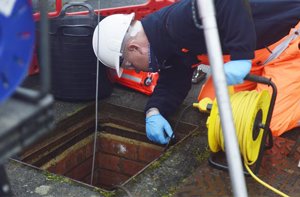
Environmental site drainage plan
Ready to discuss your project?
Please leave your details and a member of our team will reach out to discuss your requirements in more detail and arrange next steps.
We help site owners and operators ensure preparedness for a pollution incident by understanding the layout, condition and type, connectivity, capacity, and condition of your site’s drainage, so that you can ensure compliance with pollution prevention guidelines.
Site drainage can provide a primary pathway, and therefore an accurate understanding of the drainage condition and connectivity is fundamental to site environmental planning and security.
Legislation
Standards and good practice relating to drainage include:
- CIRIA C736 Containment systems for the prevention of pollution
- GPP21 Pollution incident response planning
- WRc MSCC5 Manual of sewer condition classification
- Netregs – GPP/PPG series reference importance of accurate drainage information
- BS EN 858-2:2003 Separator systems for light liquids
- CIRIA Suds manual
CIRIA C736
A survey should be carried out if there is any uncertainty about the layout, condition, or capacity of drainage systems for trade waste. Potential hazards in terms of the system’s ability to cope with major incidents should be identified. Typical hazards might include:
- combined surface and trade waste systems, especially where provided with storm overflows on or off-site
direct runoff to surface and groundwaters (i.e. rivers and soakaways). - infiltration of contaminants through defective drainage.
- unprotected clean water gullies and other devices for collecting stormwater from areas likely to become contaminated.
- inadequate or poorly maintained valves and other devices used for flow control.
- defective pipes or joints.
- blocked gullies, pipes and drains.
If comprehensive records are unavailable or have not been maintained, the site drainage system (including surface water, foul and trade effluent systems) should be surveyed. This is normally completed by a CCTV survey that will also provide evidence of physical defects with the pipework such as broken pipes, misaligned joints, root intrusion etc.
GPP 21 – Pollution incident response planning
You should include an up to date site drainage plan in your pollution incident response plan which includes foul, surface and trade effluent drainage systems. The drainage plan should include:
- surface water drainage
- the foul sewer
- any connections where trade effluent drains into the foul sewer
- inspection points to detect pollution
- oil separators/interceptors – reference 7 GPP3 Use and design of oil separators in surface water drainage systems. Firewater/spillage containment systems
- balancing tanks
- pollution control devices (shut-off valves/penstocks fitted in drains)
Features and outputs
- Ensure full compliance and thorough understanding of your sites drainage.
- Comprehensive CCTV survey of your sites drainage.
- Comprehensive report on your drainage layout, condition, and capacity to cope with trade waste and risk to surface waters.
- Risk matrix to help you identify where to direct your budget.
- Our group companies have the capability to remediate any defects found in your environmental drainage plan.
Our experts will carry out a comprehensive survey of your sites drainage systems to identify the layout, condition, and capacity to cope with trade waste as well as identifying potential hazards.
We will identify the following and ensure they are included in your drainage plan:
- Drain type – foul, storm, trade effluent, combined
- Directional flow
- Final site outfalls
- Catch pit
- Sump
- Soakaway
- Attenuation tank
- Septic tank
- Slot drainage
- Aco drains
- Gully pot
We will also identify key layout features such as:
- Operational activities
- Storage areas
- Fuelling areas
- Wash facilities
- Site topography
- Car parks
You should provide a description on how all facilities operate and make sure they are clearly labelled above ground, noting when inspection were last carried out on pollution control devices.
Our experts can also provide a topographic survey to understand the levels of a site and where contaminants will flow in a loss of product or fire.
While we are drawing up your drainage plan, our experts will check for any misconnections from your site, e.g. a foul sewer that has been linked into a watercourse. This is illegal and may lead you to respond incorrectly during a spillage.
You will receive a detailed report on the layout, condition, and capacity to cope with trade waste as well as an up-to-date drainage map which can be used to identify areas for remediation
You might also be interested in...
Environmental compliance today, creating a sustainable tomorrow
Helping you reduce risk to the environment and your operation by managing assets compliantly while achieving commercial, ESG, and net-zero goals.
Contact our experts

